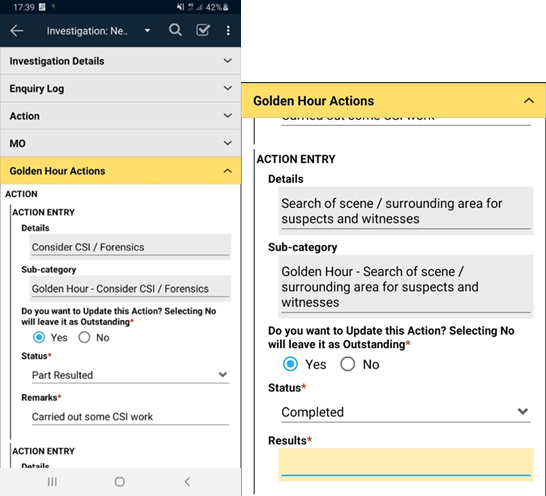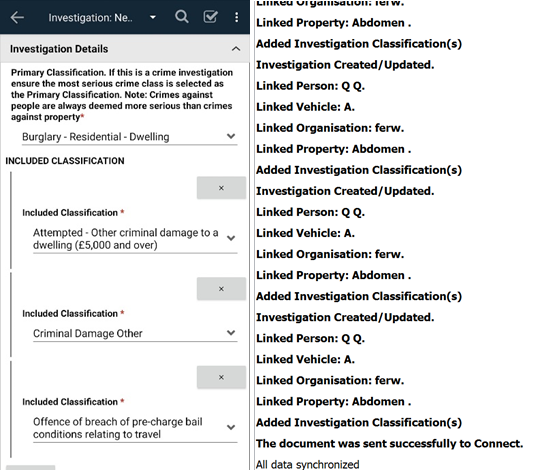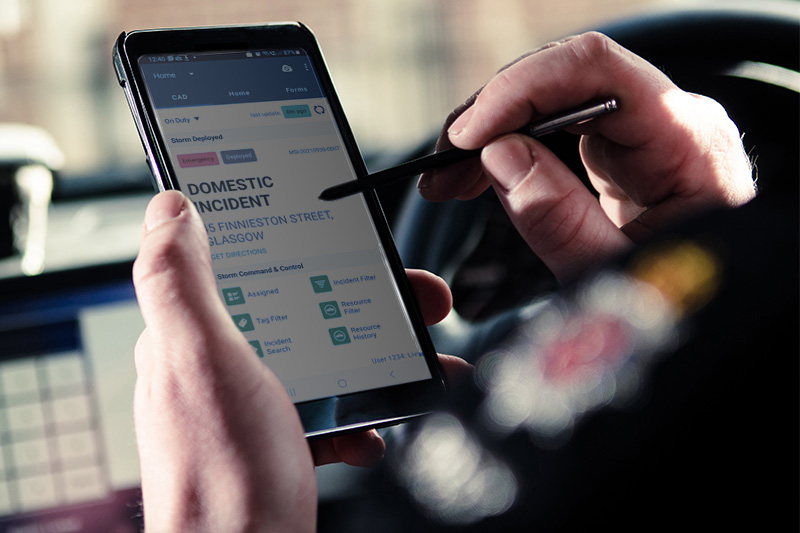Quick links
- Getting the job done
- Golden Hour Actions
- Physical Evidence Management
- Multimedia Evidence Management
- Victims Code of Practice (VCOPS)
- Telephone Witness Statements
- Suspect Identification
- Voluntary Interviews and TenPrint Enrolment
- Evidence Based Investigative Review
- BWV Linking Prior to Docking Camera
- Crime Data Integrity (CDI)
- Digital Case Files (DCF)
- Summary
Today’s frontline officers have so many local and national policies to remember it’s hardly surprising that investigations sometimes fall short of the standards the public expect. In the early nineties, all you had to think about was gathering basic details, obtaining statements and interviewing suspects before a custody officer made a charging decision. Nobody can dispute that modern procedures have added value to the quality of investigations and the treatment of victims – but only if they are followed.
In a multimedia world there are so many new sources of evidence and far more policies to ensure standards are maintained, with compliance maintained by the introduction of ever more siloed checklists. It must be overwhelming for the relatively inexperienced officers who now form the backbone of frontline teams. Technology needs to lighten the load for them, not hinder them.
Getting the job done
It is rare to hear police officers talking positively about the technology they are given. But officers in the 23 UK forces currently using Pronto often express their enthusiasm for the platform on social media and through customer engagement. The reason for this is simple: Pronto allows them to do their job thoroughly and in totality from anywhere, even without connectivity.
From a strategic perspective, new policies and legislation can be quickly incorporated into Pronto workflows, ensuring that areas of poor performance are quickly addressed. Here are some examples of how this is being successfully achieved by UK Pronto users.
Golden Hour Actions
Lancashire Constabulary had established that:
- Officers were carrying out ‘Golden Hour’ actions but not recording them
- Requesting investigation outcomes but providing no evidence to ensure minimum standards had been met
Operational officers designed a Pronto workflow to deliver capabilities which were not available in the RMS. Now, when recording or updating a crime and selecting a classification, mandated Golden Hour actions are automatically created where the officer must record activity. Outstanding actions can be updated at any time, and outcome codes can only be applied on completion of a task.

Physical Evidence Management
Property can be searched for and recorded in various Pronto workflows. The process also integrates photographs for audit and integrity and barcode or QR code scanning. By completing property ingest in this way, it can be managed completely at the scene.
Working closely with our customers, at Motorola Solutions we are currently exploring enhancements to the property workflow that may include:
- A seizure wizard, leading to an automated seize/don’t seize decision
- A property store workflow with barcode shelf locations and tasking
- A booking in/out capability, where officers pre-request items needed for court, delivered to the home station
- A disposal workflow similar to Amazon deliveries, verified with a photograph and digital signatures
- Compliance with new NPCC guidance on evidence retention, triggered by events in the criminal justice process.
These workflows will save officers and property managers hours of unnecessary work. Retained property will be reduced and will have greater audit and integrity.
Multimedia Evidence Management
Merseyside Police aimed to increase efficiency by removing the paper seizure process of multimedia from third parties and digitising each step using Pronto. They created a new workflow that captures all pertinent information regarding exhibit video streams for evidentiary purposes, such as camera system, location, system owner and any record time real time discrepancies.
Pronto’s true strength lies in its ability to integrate with over twenty back office systems.
This method eliminates data duplication, since the information retrieved from the RMS search results of the crime are reused. In the future, Merseyside plan to improve the process further by automating a seizure and continuity proforma statement by using relevant data retrieved from the completed fields.
Pronto’s true strength lies in its ability to integrate with over twenty back office systems. By connecting this workflow with the police force’s Digital Evidence Management portal, it will reduce the silo approach of duplicated searching and data entry across different systems.
Victims Code of Practice (VCOPS)
The treatment of victims by the police has been under increasing scrutiny by both the Government and the press, as is reflected in several His Majesty’s Inspectorate of Constabulary and Fire & Rescue (HMICFRS) reports.
A VCOPS option has been a crucial element in the Pronto crime reporting workflow for some time.
Indeed, new Government legislation is expected to enshrine the Victim Code Of Practice into law, giving a mandate and responsibilities to HMICFRS as well as Police and Crime Commissioners (PCCs).
A VCOPS option has been a crucial element in the Pronto crime reporting workflow for some time. The officer must complete an initial victim contract, recording their wishes and mandating how and when contact is made throughout the investigation. Officers are able to update VCOPS at any stage in an investigation by selecting options from a picklist.
We are currently working with several forces to understand how we can further increase compliance. For example:
- Automated triggers at key milestones in the investigation could keep victims informed whilst tasking the officer.
- Victims attempting to contact the OIC with regard to their crime could generate an automated task for the officer, or divert them to 101 of 999 as appropriate.
- Victims could record a video diary, documenting their feelings and recovery or changes to injuries sustained.
Telephone Witness Statements
There are several reasons why it is more difficult to obtain statements from victims and witnesses today.
- Incidents are increasingly reported via mobile phone, and key individuals are often no longer at the scene.
- The public increasingly expect the police to engage with them by virtual means such as online reporting where no initial statement is obtained.
- Officers are carrying large workloads, and often reliant on obtaining statements later in the investigation having only taken initial details
- The increase in online crime means that victims and witnesses often live outside the force area.
Using Pronto an officer can now make contact via telephone – regardless of where they or the witness are – and take a statement using the PEACE framework.
Telephone statements have been around for a few years now, but in most cases it is a service provided by a dedicated office based unit. Pronto telephone statements were rolled out to all forces in the early stages of the pandemic along with Covid fines as part of our efforts to safeguard officers and those they came into contact with. Since then this has become an increasingly popular workflow.
Using Pronto an officer can now make contact via telephone – regardless of where they or the witness are – and take a statement using the PEACE framework. The workflow includes specific questions devised by the CPS and relevant to remote witness statements. PEACE notes can be photographed as part of the workflow. Once happy with the content, the witness is emailed a link to an Azure portal which they access with unique reference numbers, where the witness can sign or reject the statement.
The officer receives a notification and will see the signed statement in their electronic pocketbook. It is also made immediately available in the RMS for other users. With this innovation statements have been successfully taken as far afield as Greece, resulting in a charge and remand. Use of this process continues to increase, recently reaching 500 instances a day in Pronto forces. Using an efficiency calculator devised by West Yorkshire Police in 2020 before rising fuel costs, this amounts to almost 100,000 hours of officer time saved and £673,000 in fuel and vehicle costs per year.
Suspect Identification
As discussed in my previous article, Pronto enables officers to conduct federated searches across multiple local and national systems including:
- Operator Initiated Facial Recognition (OIFR) & Retrospective Facial Recognition (RFR)
- Police National Computer (PNC)
- Local Records Management System (RMS)
- Computer Aided Dispatch (CAD)
- Interpol (iLEAP)
- Electoral Register
- Fingerprints via the Biometric Services gateway (BSG)
- Criminal Records (IDENT1)
- Immigration (IABS)
Mandatory justification fields appear depending upon the search selected. Search results can be reused in any of the workflows outlined in this article ensuring the integrity of the Golden Nominal as well as creating efficiencies by reducing duplication.
Voluntary Interviews and TenPrint Enrolment
Increasing the number of out of court disposals (OOCDs) is a priority for all forces because they reduce risk, deliver efficiencies and provide a more expedient journey for victims.
Where a voluntary interview is required, some forces are using BWV. However this increases the cost of uploading and storing video interviews for minor offences where an audio interview would have been PACE compliant and cheaper. As a result, many forces are still bringing suspects back to the police station and not utilising OOCDs as efficiently as they could.
The issues do not end there though. Even following a successful use of an OOCD and conviction in Court, fingerprints must still be taken at a designated police station.
An audio PACE interview in Pronto has many advantages:
- Reduced storage requirements
- PACE workflow including rights & entitlements and post interview risk assessment
- Integration to force RMS
- Integration to force DEMS
- Automated MG15 completion (Future Digital Case Files DCF)
- Future transcription capability
The Immigration Service – themselves a Pronto customer – are working with us to enrol TenPrints for their in-field operations. This will ultimately lead to a similar provision for policing: however legislation changes are required first.
Evidence Based Investigative Review
West Yorkshire Police wanted to automate the tried and tested manual process of assessing crimes for suitability to file at time of reporting. The Evidence Based Investigative Tool (EBIT) was developed and has two distinct considerations:
- The likelihood of a successful prosecution
- Is it in the public interest
Compliance is assured through dip sampling investigations. Offences where there are no viable leads can be finalised quickly, leaving more time to concentrate on those with a realistic likelihood of being solved.
BWV Linking Prior to Docking Camera
Lancashire Constabulary were keen to improve the percentage of relevant BWV footage being marked as evidential and linked to CAD references. There were two main reasons for poor compliance:
- Lack of integration resulting in errors transferring data
- Forgetfulness and poor performance
- Officers running out of time at the end of shift compounded by:
- Upload times
- Access to a desktop
Camera footage can now be viewed in Pronto directly from the camera. As with all Pronto workflows, linking and tagging to CAD and RMS can begin in a number of ways:
- Viewing the footage from a list provided by the camera and linking from:
- Deployed incident
- Assigned incidents
- Incident history
- Open workflows in the officers PNB (Use of Force, Crime etc.)
- RMS or CAD search
- From a BWV link within a workflow. (i.e. Do you have BWV to link to?)
Other functions include tagging, battery level, marking as evidential and live camera view (camera not active).
Now officers no longer have to log in to a desktop, and footage is far more likely to be linked and tagged correctly. Lancashire officers are managing on average 190 BWV links in the field every day. Assuming a conservative estimate of 20 minutes to do this via desktop, that equates to a saving of 66 hours a day.
Crime Data Integrity (CDI)
CDI is a complex area where frontline officers often fall foul because in-depth knowledge is required which comes from regular exposure. Lancashire Police identified various areas of inefficiency:
- National Crime Recording Standards (NCRS) rules state that certain additional classifications require their own separate investigation report. This meant first recognising the requirement followed by a duplication of effort in the RMS.
- Investigations with no more lines of investigation were filling the crime managers backlog due to poor knowledge and by definition poor compliance of classifications and outcomes.
Following development these issues have been eradicated. Now, if Pronto detects a code where further reports are required by NCRS counting rules, it automatically creates as many reports as are required and links them to the original.

In addition:
- If all Golden Hour actions are complete, an officer is able to request an outcome in Pronto.
- Simple, intuitive guidance leads the officer through the rules for each outcome to ensure it is accepted first time and is compliant with NCRS.
- A supervisor receives a task to check and sign off the investigation.
Digital Case Files (DCF)
Leicestershire Police were seeing high failure rates in case file compilation in their RMS. The issues ranged from missing data within MG workflows to the absence of some MG workflows altogether. The problems stemmed from the RMS not being sufficiently flexible to recognise the specific MG requirements of the case they were building, and then not ensuring particular fields were completed.
As a result of implementing the Pronto DCF wizard, a dip sample of case files indicated 100% compliance when cases were built using Pronto.
Now, a user specific case file wizard in Pronto is used to compile case files. Users are only presented with the workflows and fields that are relevant to their case and where appropriate these are mandated. Additional workflows only become visible as they progress, once users have answered specific questions about the case. The user can see which fields are non-compliant prior to submission. If all fields are grey, submission will be successful.
As a result of implementing the Pronto DCF wizard, a dip sample of case files indicated 100% compliance when cases were built using Pronto.
Summary
Pronto provides a single user interface to all aspects of an investigation including: reporting, initial investigation and Golden Hour requirements, Victim and witness care, suspect identification and management, investigative assessment, investigation, finalisation and CPS file completion. It also makes for efficient working and reduced duplication.
For the officer this means a simple process, anywhere and policy compliance without having to ask. For a force this means greater efficiencies and a better victim journey.
Pronto is trusted by over 65,000 officers because it is available wherever and whenever they need it, even offline. Continuing to evolve as policy and legislation changes, Pronto remains the only complete integration between the multiple systems accessed by officers in the field.
About the author
Ian Williams joined the Metropolitan Police in 1989 where he served in West and South London for the first 15 years of his service in frontline operational roles. The second half of his career was spent in West Yorkshire Police, specialising in neighbourhood policing, partnerships, public order and firearms command roles. The last four years of his service was spent leading the delivery of mobile policing. Ian now works for Motorola Solutions as a senior consultant in public safety software solutions with a particular focus on situational awareness and mobility.
 Motorola Solutions is a global leader in public safety and enterprise security. Our solutions in land mobile radio communications, video security & access control and command center software, bolstered by managed & support services, create the most integrated technology ecosystem built specifically for public safety and enterprise organisations that shares knowledge across your entire operation, enabling powerful collaboration, streamlining workflows, boosting performance and improving outcomes.
Motorola Solutions is a global leader in public safety and enterprise security. Our solutions in land mobile radio communications, video security & access control and command center software, bolstered by managed & support services, create the most integrated technology ecosystem built specifically for public safety and enterprise organisations that shares knowledge across your entire operation, enabling powerful collaboration, streamlining workflows, boosting performance and improving outcomes.



